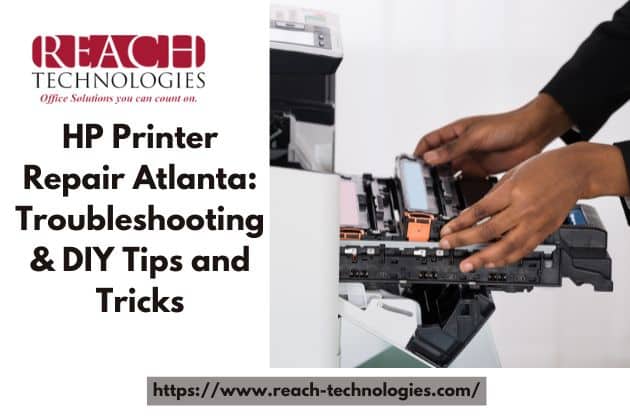
Printer connectivity issues can strike at any moment and be quite the setback – nobody likes when they’re in a hurry to print something important, only to find out that their printer isn’t cooperating.
In this blog post, we’ll explore how to troubleshoot these common connection obstacles so you don’t have your workflow interrupted by technical difficulties anymore.
How to Troubleshoot Printer Connectivity Issues
Check your printer’s connection
Before you start any printing project, double-check that your printer is properly hooked up and ready to go. Confirm the cable connections are secure or make sure wireless settings are active, then give it a quick power-on test – just to be safe.
Restart the Printer
To ensure optimal performance, power cycling your printer can be a great way to troubleshoot connectivity issues. Simply turn off the device and unplug its power cord for thirty seconds before powering it back up.
Restart your computer
Revamping your computing system can often be a quick fix to connectivity dilemmas. In certain instances, updating the network settings may be necessary and restarting your computer can assist in that process.
Check your network settings
Having trouble getting your wireless printer connected? Make sure it’s paired to the right network, or shake things up by switching networks. That could be all you need for successful printing.
Update your printer drivers
To keep your printer functioning optimally, it’s key to stay up-to-date with the latest driver versions. Make sure you visit your manufacturer’s website regularly for new downloads so all communications between your computer and printer run smoothly.
Check your firewall settings
Does your printer need a helping hand? Your firewall settings could be preventing it from connecting. To investigate, try disabling the firewall as an initial attempt to see if this solves the problem. Read about Windows Defender Firewall.
Check your antivirus settings
Antivirus programs can sometimes mistakenly interfere with printers. Make sure your settings grant access to your printing device, enabling hassle-free document production.
Reset your printer
If your printer remains unresponsive to the solutions suggested, one final step you can take is resetting it back to its manufacturer settings. For instructions on how best to do this, please see your device’s manual for guidance.
Troubleshooting printer connectivity issues can be frustrating, but following the above steps can help resolve the issue. If none of the solutions work, it may be time to contact a professional printer repair service like HP Printer Repair Atlanta. Remember to always keep your printer and computer updated with the latest software to avoid connectivity issues.
HP Printer Repair Atlanta: DIY Printer Repair Tips and Tricks
It’s always a good idea to seek professional help, but some printer issues can be fixed with a little DIY printer repair.
From minor toner issues to jammed components, discover how you can easily tackle common printer hiccups with a few DIY repair tips and tricks.
Clean the printer
Over time, dust and debris can accumulate inside your printer, causing it to malfunction. Use a soft, lint-free cloth to clean the printer’s interior and exterior. You can also use a can of compressed air to blow out any dust or debris from hard-to-reach areas.
Check the ink or toner cartridges
One of the most common printer issues is low ink or toner. If your printer is printing faintly or not at all, it’s time to replace the ink or toner cartridges. Refer to your printer manual for instructions on how to replace the cartridges.
Unclog printhead
If your printer is printing with streaks or lines, it may be due to a clogged printhead. Most printers have a cleaning utility that can unclog the printhead. Refer to your printer manual for instructions on how to use the cleaning utility.
Replace the paper feed roller
If your printer is having trouble picking up paper, it may be due to a worn-out paper feed roller. You can replace the paper feed roller yourself with a new one. Refer to your printer manual for instructions on how to replace the paper feed roller.
Check the printer’s settings
If your printer is not printing correctly, it may be due to incorrect printer settings. Ensure that your printer is set to the correct paper size, orientation, and color settings.
Use high-quality paper
Using low-quality paper can cause jams and other printer issues. Always use high-quality paper that is compatible with your printer.
Update the printer drivers
Outdated printer drivers can cause printer issues. Ensure that you have the latest printer drivers installed on your computer. You can download the latest drivers from your printer manufacturer’s website.
In conclusion, troubleshooting printer connectivity issues and DIY printer repair can save you time and money. By following the steps outlined in this blog post, you can resolve common printer issues and keep your printer in good working condition.
However, it’s important to note that not all printer issues can be resolved with DIY repairs. If you’re not comfortable with repairing your printer, or if the issue persists, seek professional help from a reputable printer repair service.
Remember to also take preventive measures to avoid printer issues in the first place. Regularly cleaning your printer, using high-quality paper, and keeping your printer drivers up to date can go a long way in preventing printer problems.
In the end, maintaining your printer and resolving issues as soon as they arise will ensure that your printer lasts longer and functions properly. So, whether you’re troubleshooting printer connectivity issues or trying your hand at DIY printer repair, take action and keep your printer in good working condition.
